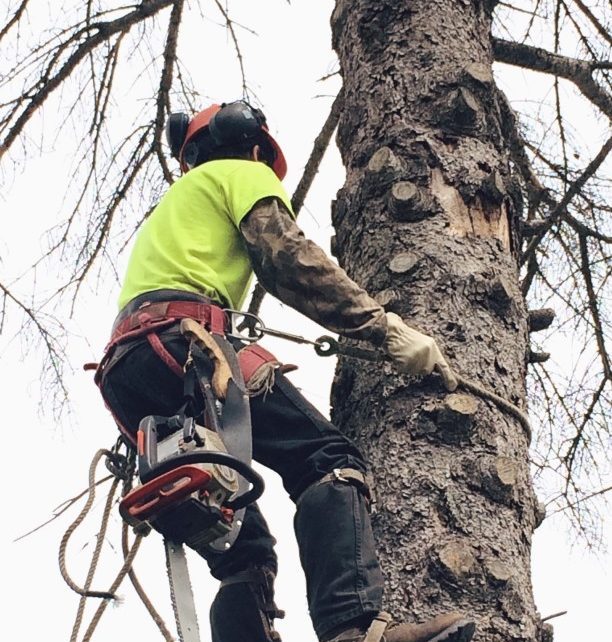So you’re in need for a tree service company? Our recent What to Look for in Hiring a Tree Trimmer guide is meant to highlight features of a tree contractor that are positives — aspects that you should look for in any company that you are considering working with. This article, on the other hand, is the opposite. It’s full of red flags! If any tree contractor has these features, then stop, and keep looking.
INCOMPLETE INSURANCE
People get insurance for their protection and also for others. The same goes for businesses. The first and top item on this list is to avoid tree contractors with incomplete or no insurance. What constitutes “complete” insurance? Due to the dangerous nature of the tree service industry, a combination of different insurances is needed to safely operate a company. But the two most vital ones are the following.
 General Liability Insurance – This type of insurance is crucial for any tree service because it provides foundational business protection. It can cover property damage and bodily injury performed on jobs. Meaning, if a tree trimmer accidentally damages your roof, this is the insurance that would help with the repair. Without it, the consumer or property owner could be held liable.
General Liability Insurance – This type of insurance is crucial for any tree service because it provides foundational business protection. It can cover property damage and bodily injury performed on jobs. Meaning, if a tree trimmer accidentally damages your roof, this is the insurance that would help with the repair. Without it, the consumer or property owner could be held liable.
Worker’s Compensation Insurance – When the tree service industry is one of the most dangerous lines of work, you, as the consumer, NEED to hire a company that has worker’s comp insurance because this is what covers employee injuries. However, not all worker’s comp coverages are created equal. Worker’s compensation is extremely expensive! So, it can be very tempting for a tree service company to completely neglect it OR to classify themselves as landscapers in order to maximize their profits.
According to WorkersCompensationShop.com, the average rates in California for tree pruning employees range from 12.58-43.53%. This means that for every $100 that an employee earns, the company has to pay up to $43.53 in worker’s compensation. Just to give an idea of how significant that rate is, clerical office employees have an insurance rate of 0.36-0.99%.
Landscapers have an average insurance rate of about 11%. Due to workplace similarities, arborists may try to designate themselves as landscapers to take advantage of lower insurance rates. The difference, however, lies in the amount of coverage. Landscapers are able to perform tree work but are limited to typically 12 feet. Therefore, if a tree trimmer disguised as a “landscaper” with their insurance company gets hurt when 20 feet from the ground, their insurance will not cover the employee’s injuries. As a result, the property owner will be held liable.
UNLICENSED
Never hire an unlicensed tree service contractor! It’s a plain and simple rule.
For any tree service company, acquiring a contractor’s license with the state is a lesson that should be taught in Managing a Tree Service Company 101. As a general rule of thumb, you can expect any large or reputable tree company to already be licensed. A tree service company simply wouldn’t be able to grow to such a large status without it. However, if you come across a one-man operation, it would be a good idea to verify their license.
To learn more about why licensed tree contractors are the only way to go, please visit our What to Look for in Hiring a Tree Trimmer article for more information.
HIGHLY-DISCOUNTED COUPONS
We’ve all seen them. Coupons for 25% off! 30% off! Who doesn’t love a good coupon? And what’s not to love? Coupons work great for shaving some dollars off of a pizza order or new shoes. Those are items that typically do not cost thousands of dollars. Tree services, on the other hand, will generally cost well over $1,000.
Due to the hazardous nature of the tree service industry,  expenses are high and profit margins are low. It makes it difficult for any arborist to offer a large discount of more than 25% off. Let’s break it down. A tree company has a net profit margin of 15% (which for the arborist industry is considered to be very good). That means that after all expenses are paid, such as payroll, insurance, and gas — only 15% of revenue is left. This company quotes a customer $1,000 for a tree pruning. But wait! This particular customer has a 30% off discount coupon! That’s a whopping $300 off — leaving the business with only $700 left for wages, truck payments, gas, insurance, dump fees, etc.
expenses are high and profit margins are low. It makes it difficult for any arborist to offer a large discount of more than 25% off. Let’s break it down. A tree company has a net profit margin of 15% (which for the arborist industry is considered to be very good). That means that after all expenses are paid, such as payroll, insurance, and gas — only 15% of revenue is left. This company quotes a customer $1,000 for a tree pruning. But wait! This particular customer has a 30% off discount coupon! That’s a whopping $300 off — leaving the business with only $700 left for wages, truck payments, gas, insurance, dump fees, etc.
The only way an arborist would be able to offer such a hefty discount is if they mark up the standard market rate for a particular service in order to make up for the loss in revenue from the coupon. This is what price gouging looks like. You need your large tree trimmed. Other companies would quote roughly $2,000. But you don’t even bother getting multiple quotes because you found an awesome coupon in a local coupon book for 30% off of tree trimming services! So why look elsewhere? You’ll be saving hundreds of dollars with this coupon! This tree service company that you contacted tells you that it would normally charge $3,000 — but since your coupon shaves of 30% — your estimate now comes to $2,100. So as you see, it still falls into the same ballpark as the other companies without the coupon.
You may wonder why all of that matters? Well, what happens next time you need your tree trimmed, but you don’t have a coupon. Will they still offer you a deal? Or is their quote going to be significantly higher? Does it mean that you’ll need to spend more time again trying to figure out what tree service company to use AGAIN? Once people find a tree contractor that they like — whose work and people they trust — they tend to stick with them. Why spend all that time researching different companies and meeting with multiple estimators, when you can just go straight to the one you know?
In addition, it’s important for you to feel like you can trust your tree service company. Discounting overinflated prices is a common sales technique that many businesses use, especially in the product-based sector. It’s a pricing strategy that is effective in moving a consumer towards a purchase because they feel like they are getting a good deal — until they do a little more research and realize that their “good deal” is in line with other quotes.
POOR CUSTOMER SERVICE
The tree service industry is filled with a wide array of characters. Some companies consist of administrative personnel and field staff. And when you have your in-person estimate, you will typically be meeting with an estimator or project manager, whose job is solely customer service. So you can expect them to be professional and have strong interpersonal skills.
On the other end, some companies are a one-man show. When you have your initial visit for an estimate, you’ll be meeting with your actual tree trimmer. Tree trimmers climb trees with chainsaws and drag brush for a living. They don’t mind getting dirty and minor injuries tend to not faze. Their goal each day is to not only do a great job with the trees they’re working on, but also quite frankly— to not die! Customer service is secondary. So sometimes, you may not get the best customer experience throughout your entire journey with this particular “contractor”.
This doesn’t mean that all one-man operations provide menial customer service. Even LC Tree Service had to begin somewhere. Some of these small companies are run by great people who are highly proficient at what they do. So whether you’re dealing with a single person or a large enterprise, it’s important that you have good interactions. Do you feel that your trees are in good hands? Do you feel like your requests were heard and will be taken care of? Do you feel like you can trust the individual and the company? If you don’t, then you should look elsewhere.


